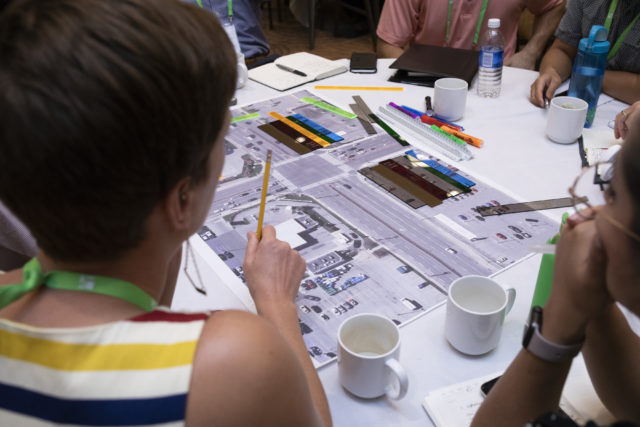Over the past decade, North American cities have risen to the challenge of changing transportation pressures. Whether for safety, congestion management, or climate action, the way cities design streets is changing. NACTO supports this work by building city capacity to design streets that foster more safe, efficient, accessible, and sustainable communities.
 One of the ways we do this is through our certified training program, which brings together staff and leadership working on street design for hands-on trainings and workshops based on policy and content from NACTO’s design guides and case studies from member cities. These events are an unparalleled opportunity for staff to learn about cutting edge design features and apply them in real-world exercises for streets in their own communities.
One of the ways we do this is through our certified training program, which brings together staff and leadership working on street design for hands-on trainings and workshops based on policy and content from NACTO’s design guides and case studies from member cities. These events are an unparalleled opportunity for staff to learn about cutting edge design features and apply them in real-world exercises for streets in their own communities.
These intensive events focus on strengthening planning professionals’ design and conceptual knowledge through interactive and engaging in-person trainings. Training content is tailored to meet staff where they are, cross-referencing material and concepts to address the specific priorities host cities identify for their streets. Typically, trainings take place over one day, with a morning seminar and afternoon design charrette. Many cities also take advantage of the presence of nationally recognized design leaders to hold additional events for policymakers, civic leaders, and the public, expanding the NACTO experience from one day to a momentum-building few days of activity..
Through our participation in the American Cities Climate Challenge, NACTO is fortunate to bring trainings to 25 cities around the U.S. at no cost, supporting their work to decrease carbon emissions by designing streets for more multimodal transportation options. In 2019, we traveled to Honolulu and St. Petersburg, among others, for day-long trainings on topics relevant to transportation and climate action plans in both cities.
RECENT TRAININGS:
Honolulu, November 2019
Hawaii’s largest city wants safer conditions for pedestrians, but is currently limited by existing policies, including how they evaluate and install crosswalks. Crosswalks are currently removed if they don’t meet certain design or use criteria, which can reduce safety; people don’t necessarily stop crossing the street when a crosswalk is removed, but they do lose dedicated infrastructure. Our recent training with Honolulu city and county staff focused on tools to bring pedestrian crossings up to existing standards while also encouraging more people to use them.
The training featured real-world examples from peer cities and allowed staff to take a fresh look at many of Honolulu’s intersections. Attendees learned about within-reach design changes to pedestrian crossings (e.g. rapid beacons, quick-build medians) and identified procedural changes to incorporate these treatments into their planning process. They focused their attention on two typical locations that capture common conditions and developed toolsets to apply to intersections across Honolulu.
By taking advantage of NACTO’s training program staff from Honolulu’s local, regional and state agencies analyzed their crosswalk design and implementation process. This will help staff as they continue to holistically address safety issues, expand high-quality pedestrian crossings, and make lasting impacts on their street transportation system.
“The session was fantastic”
– Attendee, City & County of Honolulu
St. Petersburg, December 2019
St. Petersburg is serious about complete streets. In concert with other multimodal and placemaking projects, the City is planning to build a new bus rapid transit line to link downtown communities to the region’s destinations and beaches. This investment signals the City’s commitment to enhancing multimodal options for residents and visitors. To help capitalize on the impact of this project, the focus of our recent training in St. Petersburg was using street design to realize the potential of complete streets.
In one day, NACTO’s team presented best practices for complete streets where bus and bike connections play a strong role. With attendees, we detailed design elements for high-quality bike lanes and discussed how to integrate these facilities with transit. We wrapped up this workshop with a real-world design exercise centered around St. Petersburg’s focus: developing the BRT corridor on 1st Aves North and South into complete streets by improving transit, bike, and pedestrian access.
“The content was exactly what we were hoping for”
– Attendee, City of St. Petersburg
While Honolulu and St. Petersburg focused on different modes, they share similar ideals: developing multimodal transportation systems by creating safer, more reliable ways for people to travel by walking, biking, or transit. Tapping into the rich body of knowledge of NACTO cities is one way they’re realizing this goal. Our training program seeks to apply state-of-practice design thinking to real-world scenarios for host cities. Trainings give attendees a chance to dive deep into topics together, looking at project challenges in a new light, brainstorming solutions, and applying new strategies as a team.
Our Certified Training program doesn’t end after a day-long workshop; the policies, treatments, and concepts we cover continue to make impacts as cities apply them when they plan, design, and deliver street redesign projects. This program is focused on the bread and butter of NACTO’s mission: empowering cities to make meaningful change.
Over the next year, we’re looking forward to hosting more design trainings, both with Climate Challenge cities and other municipalities and agencies across North America. Stay tuned for recaps of some of these workshops, and if you work for a city or government agency that would like to host a NACTO certified training, please let us know.